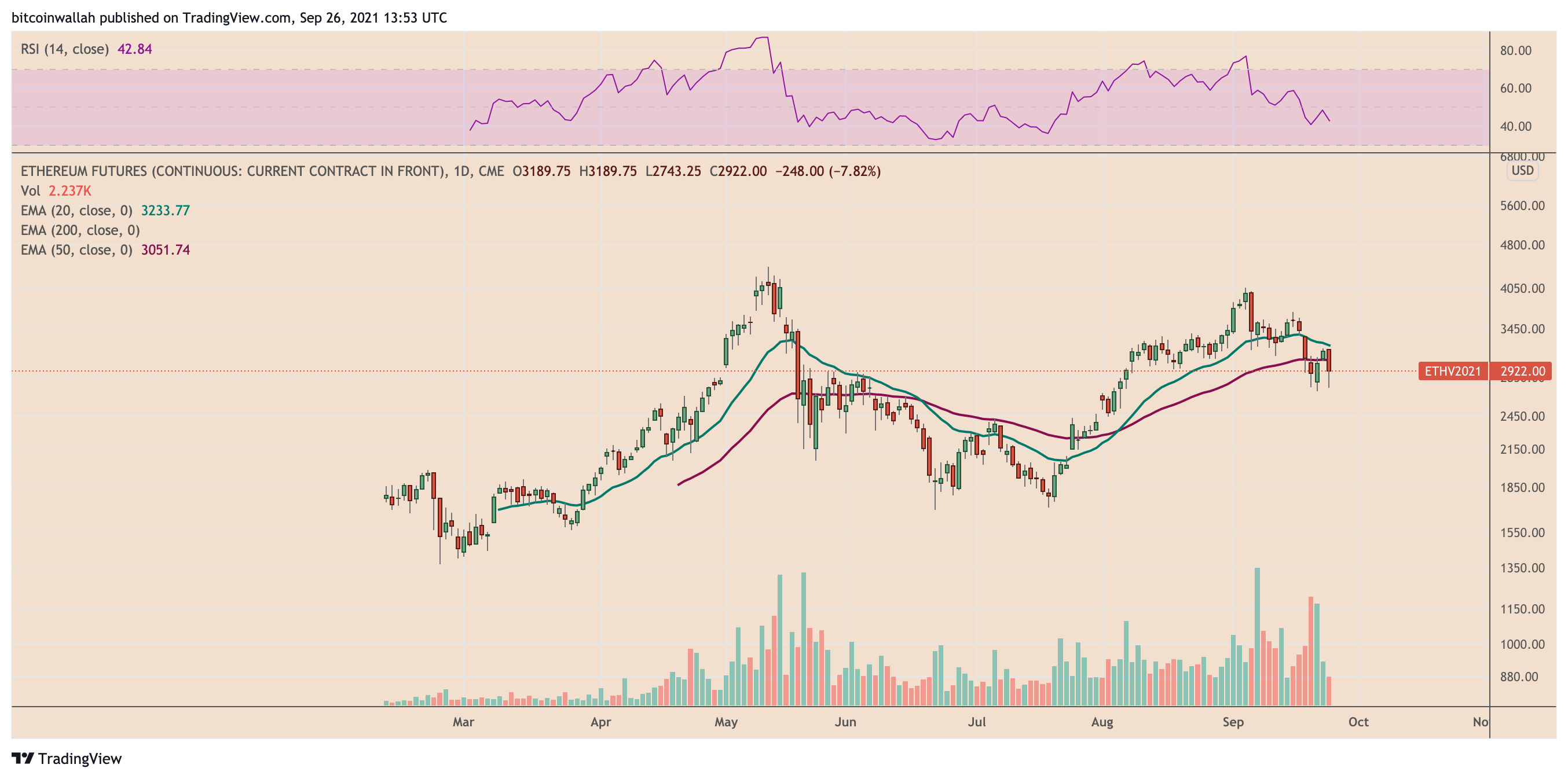
Chinese authorities are moving to prevent further financial contagion as a bank run unfolds in one of its provinces. Thousands of customers lined up to withdraw their money amid worries the Bank of Cangzhou is at risk of going under, CNN reports, citing state-run Chinese media. The regional bank lent hundreds of millions of dollars […]
The post Financial Fears Trigger Bank Run in China As Officials Push To Prevent Contagion: Report appeared first on The Daily Hodl.

The premium on CME Bitcoin futures dropped to zero, but data shows pro traders are still bullish.
Looking at the Bitcoin chart from a weekly or daily perspective presents a bearish outlook and it's clear that (BTC) price has been consistently making lower lows since hitting an all-time high at $69,000.

Curiously, the Nov. 10 price peak happened right as the United States announced that inflation has hit a 30-year high, but, the mood quickly reversed after fears related to China-based real estate developer Evergrande defaulting on its loans. This appears to have impacted the broader market structure.
This initial corrective phase was quickly followed by relentless pressure from regulators and policy makers on stablecoin issuers. First came VanEck's spot Bitcoin ETF rejection by the U.S. Securities and Exchange Commission on Nov. 12. The denial was directly related to the view that Tether’s (USDT) stablecoin was not solvent and concerns over Bitcoin's price manipulation.
On Dec. 14, the U.S. Banking, Housing and Urban Affairs Committee held a hearing on stablecoins focused on consumer protection and their risks and on Dec. 17, the U.S. Financial Stability Oversight Council (FSOC) voiced its concern over stablecoin adoption and other digital assets. "The Council recommends that state and federal regulators review available regulations and tools that could be applied to digital assets," said the report.
The worsening mood from investors was reflected in the CME's Bitcoin futures contracts premium. The metric measures the difference between longer-term futures contracts to the current spot price in regular markets.
Whenever this indicator fades or turns negative, this is an alarming red flag. This situation is also known as backwardation and indicates that bearish sentiment is present.

These fixed-month contracts usually trade at a slight premium, indicating that sellers are requesting more money to withhold settlement for longer. Futures should trade at a 0.5% to 2% annualized premium in healthy markets, a situation known as contango.
Notice how the indicator moved below the “neutral” range after Dec. 9 as Bitcoin traded below $49,000. This shows that institutional traders are displaying a lack of confidence, although it is not yet a bearish structure.
Exchange-provided data highlights traders' long-to-short net positioning. By analyzing every client's position on the spot, perpetual and futures contracts, one can better understand whether professional traders are leaning bullish or bearish.
There are occasional discrepancies in the methodologies between different exchanges, so viewers should monitor changes instead of absolute figures.

Despite Bitcoin's 19% correction since Dec. 3, top traders at Binance, Huobi, and OKEx have increased their leverage longs. To be more precise, Binance was the only exchange facing a modest reduction in the top traders' long-to-short ratio. The figure moved from 1.09 to 1.03. However, this impact was more than compensated by OKEx traders increasing their bullish bets from 1.51 to 2.91 in two weeks.
Related: SEC commissioner Elad Roisman will leave by end of January
The lack of a premium in CME 2-month future contracts should not be considered a 'red alert' because Bitcoin is currently testing the $46,000 resistance, its lowest daily close since Oct. 1. Furthermore, top traders at derivatives exchanges have increased their longs despite the price drop.
Regulatory pressure probably won’t lift up in the short term, but at the same time, there's not much that the U.S. government can do to suppress stablecoin issuance and transactions. These companies can move outside of the U.S. and operate using dollar-denominated bonds and assets instead of cash. For this reason, currently, there is hardly a sense of panic present in the market and from data shows, pro traders are buying the dip.
The views and opinions expressed here are solely those of the author and do not necessarily reflect the views of Cointelegraph. Every investment and trading move involves risk. You should conduct your own research when making a decision.
 Bitmex co-founder and cryptocurrency investor Arthur Hayes has addressed the current state of the market with the effect the U.S. Federal Reserve’s upcoming tapering process may have. Hayes also links this with the Evergrande situation in China and advises cryptocurrency newcomers to hold on until new signals emerge next year. Arthur Hayes Analyzes the Current […]
Bitmex co-founder and cryptocurrency investor Arthur Hayes has addressed the current state of the market with the effect the U.S. Federal Reserve’s upcoming tapering process may have. Hayes also links this with the Evergrande situation in China and advises cryptocurrency newcomers to hold on until new signals emerge next year. Arthur Hayes Analyzes the Current […]
Bitcoin price has yet to reclaim the $50,000 level, but the actions of options market makers and margin traders at Bitfinex suggest the most recent correction is over.
Bitcoin (BTC) has been struggling to sustain the $47,500 support since the Dec. 4 crash, a movement that wiped out over $840 million in leveraged long futures contracts. The downside move came after the emergence of the Omicron variant of the Coronavirus and recent data showing U.S. inflation hitting a 40-year high.

While newcomers might have been scared by the 26% price correction over the past month, whales and avid investors like MicroStrategy added to their positions. On Dec. 9, MicroStrategy announced that they had acquired 1,434 Bitcoin, which increased their stake to 122,478 BTC.
According to some analysts, the rationale behind Bitcoin’s weakness was the contagion fear that Evergrande, a leading Chinese property developer, defaulted on its US dollar debt on Dec. 9. The $1.1 Bitcoin billion options expiry on Dec. 10 also could have played an important factor because bears pocketed a $300 million profit.
Margin trading allows investors to leverage their positions by borrowing stablecoins and using the proceeds to buy more cryptocurrency. When those savvy traders borrow Bitcoin, they use the coins as collateral for shorts, meaning they are betting on a price decrease.
That is why some analysts monitor the total lending amounts of Bitcoin and stablecoins to gain insight into whether investors are leaning bullish or bearish. Interestingly, Bitfinex margin traders slightly reduced their longs ahead of the Dec. 4 price crash.

Notice that the indicator held a decent 90% favoring longs, meaning stablecoin borrowing was only 10% of the Bitfinex total. Furthermore, the margin longs recovered by 94% less than 24 hours after the price crash. This suggests that even if those investors were caught by surprise, most held their positions throughout the movement.
To confirm whether this movement was specific to the instrument, one should also analyze options markets. The 25% delta skew compares similar call (buy) and put (sell) options. The indicator will turn positive when “fear” is prevalent as the protective put options premium is higher than similar risk call options.
The opposite holds when market makers are bullish, causing the 25% delta skew to shift to the negative area. Readings between negative 8% and positive 8% are usually deemed neutral.

The 25% delta skew ranged near 6% ahead of the Dec. 4 Bitcoin crash, which is considered neutral. Over the next 3 days the options market makers and whales displayed moderate fear as the indicator peaked at 10%, but currently it stands at 3%.
The Bitfinex margin long metric and the options main risk metric show few signs of stress in derivatives markets. Considering that these markets are more often used by pro traders, one can begin to believe in the narrative that Bitcoin will claim a new all-time high in early 2022.
The views and opinions expressed here are solely those of the author and do not necessarily reflect the views of Cointelegraph. Every investment and trading move involves risk. You should conduct your own research when making a decision.
 In mid-September China’s Evergrande Group, the country’s second-largest property developer by sales, sparked fear in the global economy as the company’s market valuation plummeted to an 11-year low. Global economists have warned that if Evergrande defaults on its debts, it could start a credit contagion similar to the Lehman Brothers bankruptcy in 2007. So far, […]
In mid-September China’s Evergrande Group, the country’s second-largest property developer by sales, sparked fear in the global economy as the company’s market valuation plummeted to an 11-year low. Global economists have warned that if Evergrande defaults on its debts, it could start a credit contagion similar to the Lehman Brothers bankruptcy in 2007. So far, […]
Fears about the stock market and Tether's reserves have also led some to believe the Bitcoin price could be in trouble.
Conflicting news about whether Chinese property giant Evergrande had defaulted on its overdue loan payments emerged just before Bitcoin’s recent price crash.
Evergrande Group is China’s second-largest property developer and is in debt for roughly $300 billion. There are fears that its collapse could spark a wider financial crisis.
Two minutes after Evergrande’s payment was due, the Deutsche Markt Screening Agentur (DMSA) issued an announcement on Nov. 10 at 4 p.m. UTC stating that it was preparing bankruptcy proceedings against Evergrande.
Two hours later at about 6 .p.m. UTC, Bitcoin began it’s hours-long pullback to $62,800.
Media outlet Morning Brew reported about 45 minutes later that Evergrande had missed a payment on its outstanding debt which was due on Wednesday at 4 p.m. UTC and defaulted. Another 45 minutes passed before Bloomberg issued a story saying that it hadn’t.
Prices stabilized around $64,500 several hours after the initial drop. This was around the same time Bloomberg reporter Allison McNeely’s tweeted “contrary to what you may have heard ~on the internet~ Evergrande did not default today.”
William Fong, senior trader at Australian crypto-asset investment platform Zerocap, told Cointelegraph:
"Evergrande has not officially defaulted on any of its offshore debt obligations in the international USD bond market."
“Bottom-line, $148 million is nothing compared to the $300 billion outstanding debt of Evergrande, but it does create a concern for the $100 billion outstanding ‘keep-well’ structured offshore bonds by Chinese SoEs and corporates,” he stated.
Fong believes that a bailout for Evergrande will not come any time soon because “Chinese regulators were the initiators of a cap aimed at over-expansion in developer’s leverage,” adding:
“This has created potential contagion risk across the entire property developer space and has expanded towards financial institutions and industries dependent on the sector as well.”
Some believe the Bitcoin price could also be at risk from a stock market meltdown and due to fears that nearly half of Tether’s reserves are made up of commercial paper, amounting to nearly $30 billion. This is enough for Financial Times to place Tether among “global giants” in that category.
Related: Record-high inflation prompts investors to take a closer look at Bitcoin
However, Tether has denied that it holds any commercial paper from Evergrande, though it may be exposed to Chinese companies. Commercial paper is a corporate debt note with a short expiration date, usually under a year.

Ethereum prices recovered on Sunday amid a market-wide upside correction while receiving an additional upside boost from a bullish JPMorgan & Chase report.
Ethereum's native token Ether (ETH) staged a rebound on Sept. 26 following a massive decline earlier this week that saw its prices plunging to as low as $2,651 on Coinbase.
The ETH/USD exchange rate rose 3.63% to hit an intraday high of $3,030. The upside move amounted to a 14.3% upside retracement from the pair's week-to-date low at $2,651, showing that traders attempted to retain their bullish bias despite potential headwinds ahead.
Last week, Ether prices fell due to a flurry of issues arising from China. On Monday, traders dumped crypto assets en masse after a tumult in China's heavily indebted property market prompted a selloff across global stock markets.
A rebound move ensued later in the week but met with another selloff on Friday after People's Bank of China reiterated that crypto transactions are illegal. Nonetheless, Ethereum bulls maintained their foothold and pushed prices back above $3,000, a psychological resistance level.

The sentiments were similar across some top crypto assets, with the benchmark cryptocurrency Bitcoin hitting an intraday high of $43,767 on Coinbase following a 2.49% upside move. Meanwhile, Uniswap exchange's native asset UNI also fared higher by more than 19%, becoming the top-performing crypto asset at least in the previous 24 hours.
At the same time, Ethereum's top rivals Cardano (ADA) and Solana (SOL) performed poorly, with ADA/USD dropping more than 5% and SOL/USD losing over 3% on a 24-hour adjusted timeframe.
Ethereum gains also followed a bullish report thifrom JPMorgan & Chase. The study noted that institutional investors have started increasing their exposure in Ethereum markets.
Analysts at JPMorgan credited the ongoing craze in the decentralized finance (DeFi) and nonfungible token (NFT) sector as the primary driver behind investors' interest in Ethereum. They added that the 21-day average Ethereum Futures premium climbed to 1% over spot ETH prices, citing the Chicago Mercantile Exchange (CME) data recorded since August.

The JPMorgan report coincided with a record amount of Ether tokens getting withdrawn out of all crypto exchanges, as per data provided by CryptoQuant. At press time, the net ETH reserves on trading platforms had dropped to 18.44 million ETH compared to 23.94 million ETH a year ago.
Related: Ethereum drops more than Bitcoin as China escalates crypto ban, ETH/BTC at 3-week low
Independent analyst PostyXBT also anticipates a potential further price rebound in Ethereum markets, noting that the cryptocurrency's latest declines had pushed it inside a classic accumulation range, as shown in the chart below.

"Weekly close equally as important for ETH today as price tests the previous range highs as support," the analyst noted.
"Seems like a logical area to make a higher low and I have bought more here for long-term bags/swing trade. RR looks favorable after a 33% correction from the local top."
The views and opinions expressed here are solely those of the author and do not necessarily reflect the views of Cointelegraph.com. Every investment and trading move involves risk, you should conduct your own research when making a decision.
 The world is still focused on the financial downfall of China’s real estate giant Evergrande and according to Chinese authorities have told the private sector to get “ready for the possible storm.” Reports show that even though the People’s Bank of China already provided $18.6 billion in liquidity to ease the brunt, Beijing may not […]
The world is still focused on the financial downfall of China’s real estate giant Evergrande and according to Chinese authorities have told the private sector to get “ready for the possible storm.” Reports show that even though the People’s Bank of China already provided $18.6 billion in liquidity to ease the brunt, Beijing may not […]
Meanwhile, the amount staked in Ethereum 2.0 smart contracts reached over 7.75 million ETH.
The total amount of Ether (ETH) held by all the crypto exchanges fell to its lowest levels, just as its prices rose back above $3,000 per token on Sept. 23.
Data collected by CryptoQuant, a blockchain analytics platform, showed that exchanges' net Ethereum token reserves dropped to 18.533 million ETH, compared to 23.92 million ETH a year ago. Meanwhile, the cost to purchase one Ether rose from almost $349 to as high as $3,078, showcasing an inverse correlation between ETH reserves on exchanges and prices.

Lower exchange reserves point to traders' likelihood of holding the underlying cryptocurrency than trading it for other digital/fiat assets. Hence, if the demand for the token tends to rise, the lack of adequate supply helps to boost prices.
So it appears, Ethereum's native token has started fitting the classic low supply-high demand bullish model. For instance, Dapp Radar reported that the total value locked (TVL) across the decentralized applications industry reached $142 billion, out of which 68% was concentrated on the Ethereum network as of August 2021.
On the other hand, more and more Ether tokens started going out of active supply after Ethereum announced its staking feature in Nov 2020, as the network geared up to become a full-fledged proof-of-stake blockchain by 2022.
In detail, the TVL inside the so-called Ethereum 2.0 smart contracts rose from 11,616 ETH in November 2020 to 7.75 million ETH today.

Additionally, a major network upgrade on August 5, 2021, dubbed London Hard Fork, added a feature that trimmed the pace at which Ether supply grows. The change, called EIP-1559, started splitting almost 13,000 new ETH issued every day for miner payment fees into three parts.
The network started burning one of these splits—the base fee users pay to miners to process transactions. As a result, more ETH tokens went out of supply. Data tracking portal WatchTheBurn.com noted that the EIP-1559 feature has contributed in the burning of 352,262 ETH to date, which is about $1.1 billion per the current exchange rates.
Lark Davis, an independent cryptocurrency market analyst, stated that the ongoing supply-demand dynamics in the Ethereum market would help shoot ETH prices towards $10,000.
#ethereum supply on exchanges just keeps dropping, and the price just keeps rising. $10,000 is programmed in already. pic.twitter.com/jRTUYHK4Ca
— Lark Davis (@TheCryptoLark) September 17, 2021
Cryptocurrency markets this week performed in response to a looming housing crisis in Chinese property sector and its ripple effect across global economies.
In detail, the ETH/USD exchange rate dropped 20.78% in the first two days of this week, going to as low as $2,651, as investors limited exposure in riskier markets and scrapped for safest havens like the U.S. dollar and Treasury bonds. Fears of contagion from the debt crisis at China Evergrande Group, which owes billions of dollars of bonds to global investors, sparked the sell-off.

Ether bounced by as much as 18.82% after bottoming out locally at $2,651, including a 2.33% increase to $3,150 on Thursday. Nonetheless, the cryptocurrency's 50-day exponential moving average (50-day EMA) near $3,191 and 20-day EMA near $3,291 acted as strong resistance targets.
Related: Ethereum forming a double top? ETH price loses 12.5% amid Evergrande contagion fears
Blockchain data tracking service Santiment noted that the Ethereum token might keep bouncing as long as its short-term holders remain unprofitable. The portal cited the market value to realized value (MVRV) ratio—calculated on a seven-day average—behind its bullish analogy.

Excerpt from Santiment's Wednesday report:
"Short-term wise, MVRV 7D is suggesting a bounce, but the real rally is unlikely until we get closer to the next major speculative event - The transition to Proof-of-Stake (PoS) in 2022."
The views and opinions expressed here are solely those of the author and do not necessarily reflect the views of Cointelegraph.com. Every investment and trading move involves risk, you should conduct your own research when making a decision.